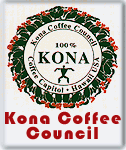|
History (Note: This article is a reprint from Wikepedia)
The coffee plant was first brought to Kona in 1828 by Samuel Reverend Ruggles, from Brazilian cuttings,although it was not until much
later in that century that it became a consistent and worthwhile crop. It was grown on large plantations, but the 1899 world coffee
market crash caused plantation owners to have to lease out their land to their workers. Most of these workers were originally from
Japan, originally brought in to work on large sugarcane plantations. They worked their leased parcels of between 5 and 12 acres as
family concerns, producing large, quality coffee crops. The tradition of running family farms has continued throughout Kona.
The Japanese-origin families have been joined by Filipinos, mainland Americans, and Europeans. There are approximately 800 Kona
coffee farms, with an average farm size of less than 5 acres (20,000 m2). In 1997 the total Kona coffee area was 2,290 acres (9 km2)
and green coffee production just over two million pounds.
Growing and processing
Kona coffee blooms in February and March. Small white flowers cover the tree and are known as Kona Snow. In April, green berries begin
to appear on the trees. By late August, red fruit, called "cherry" because of the resemblance of the ripe berry to a cherry fruit,
start to ripen for picking. Each tree will be hand-picked several times between August and January, and provides around 20-30 pounds
of cherry. Within 24 hours of picking, the cherry is run through a pulper, the beans are separated from the pulp, and then placed
in a fermentation tank overnight. The fermentation time is dependent on the temperature and therefore on the elevation; about 12
hours at a low elevation or 24 hours at a higher elevation. The beans are rinsed and spread to dry on a hoshidana or drying rack.
Traditional hoshidanas have a rolling roof to cover the beans in the event of rain. It takes 7-14 days to dry the beans to an optimal
moisture level of between 10-13% (by Hawaii Dept. of Agriculture regulations: 9.5-12.5%). From here, the beans are stored as
"pergamino" or parchment. The parchment is milled off the green bean prior to roasting or wholesale. Kona coffee beans are
classified according to the seed type. Type I beans consist of two beans per cherry, flat on one side, oval on the other.
Type II beans consist of one round bean per cherry, otherwise known as a peaberry. Further grading of these two types of beans
depends on size, moisture content, purity of bean type and size. The grades of Type I Kona coffee are Kona Extra fancy, Kona fancy,
Kona Number 1, "Kona Select" ,and Kona Prime. The grades of Type II Kona coffee are Peaberry Number 1 and Peaberry Prime. There is
also a lower grade of coffee called Number 3 which can not legally be labeled as "Kona". Infestations of the Root-knot nematode
damaged many trees in the Kona districts in the 1990s. Symptoms are single or clusters of trees with stunted growth, especially when
transplanted. In 2001, rootstock from the Coffea liberica species was found to be resistant to the nematodes. It could be grafted with
Coffea arabica 'Guatemala' variety to produce a plant that both naturally resists the pest, as well as produces a quality coffee product.
The combination was named after Edward T. Fukunaga (1910-1984), who was superintendent of the University of Hawaii's Kona Research
Station in Kainaliu in the 1950s through the 1970s.
Kona blends
Because of the rarity and price of Kona coffee, some retailers sell "Kona Blends". These are not a combination of different Kona
coffees, but a blend of Kona and Colombian, Brazilian or other foreign coffees. Usually they contain only the minimum required 10%
Kona coffee and 90% cheaper imported beans. Current Hawaiian law requires blends to state the percentage of Kona coffee on the label.
There is no matching Federal law. Some retailers use terms like Kona Roast, or Kona Style. To be considered authentic Kona coffee,
the state of Hawaii's labeling laws require the prominent display of the words "100% Kona Coffee".
Recent developments
In the 1990s, a company called Kona Kai Farms, in Berkeley, California, was sued on behalf of Kona coffee growers. In October 1996,
federal officials in San Francisco indicted Kona Kai Farms executive Michael Norton on wire fraud and money laundering charges. He
was found to have put Central American coffee into bags with labels indicating it was Kona coffee since 1993.[5] In 2000 Michael
Norton pleaded guilty to one count of wire fraud and one count of tax evasion. Some Kona farms have become successful tourist
attractions. Although some roadside stands are allowed with special permits, large gift shops at some areas that are zoned agricultural
have met local resistance.
|

